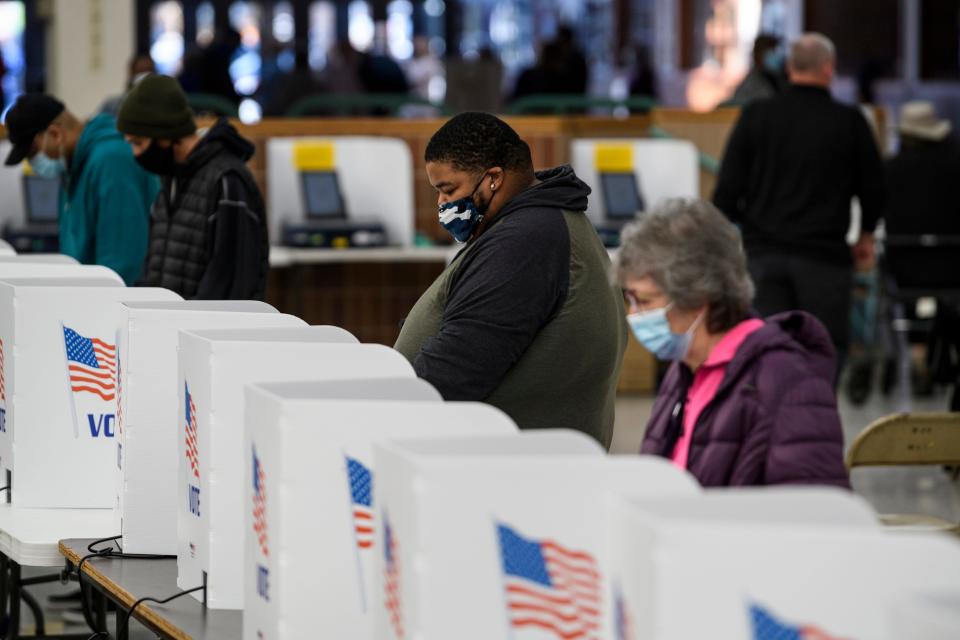Voting rights are still a battleground in Indiana
EDITOR'S NOTE: This page is part of a comprehensive guide to voting rights across the U.S. and in Puerto Rico.
Indiana never was a target of the U.S. Voting Rights Act's special provisions. It was in the courts that the state would make its mark on voting rights.
Indiana's voter ID law, which requires Hoosiers voting in person to show government-issued photo ID, was the focal point for much of the action. The U.S. Supreme Court upheld the 2005 statute in 2008 in the case of Crawford v. Marion County Election Board, but the League of Women Voters brought a new suit in state court a few months later. The law was struck down by a state appellate court in 2009, only to be upheld the following year by the Indiana Supreme Court.
Opponents of the voter ID law argued the statute discriminated between and among different classes of voters and disproportionately affected economically disadvantaged and minority voters. But the state argued the law spoke to legitimate concerns about in-person voting fraud.
Indiana was on the cusp of something big, said Luis Fuentes-Rohwer, a professor at Indiana University's Maurer School of Law who studies the Voting Rights Act.
"Crawford paved the way (for voter ID laws in other states), but in the sense that other states were already doing, thinking, debating these laws," Fuentes-Rohwer said. "They could say, ‘Well, clearly we can do this,’ meaning voter ID laws. It’s a blueprint for how the court would understand these cases."
Fuentes-Rohwer pointed to other court cases lesser known than Crawford, but arguably just as influential on voting rights law.
In Davis v. Bandemer, a 1986 U.S. Supreme Court case, the high court sustained Indiana’s 1981 state apportionment plan against the claim that it was Republican gerrymandering — the manipulation of electoral boundaries to favor one party by diluting the impact of the other party's voters.
But the real significance of the case, Fuentes-Rohwer said, was that the Supreme Court ruled federal courts could find cases alleging partisan gerrymandering worthy of intervention under the U.S. Constitution's Equal Protection Clause.
"That was the first case to squarely confront the issue of political gerrymandering by the U.S. Supreme Court," he said.
Black residents in Indiana challenge discriminatory districts
A third U.S. Supreme Court case from Indiana, 1971's Whitcomb v. Chavis, inspired Congress to liberalize Section 2 of the Voting Rights Act when it was renewed in 1982, Fuentes-Rohwer said.
The suit was brought by economically disadvantaged and Black residents of Marion and Lake counties challenging state law that established Marion County as a multi-member district for the election of state legislators.
"The argument was, 'Are the votes of people living in multi-member districts diluted when you combine them into the one big district rather than making specific single-member districts (with boundaries drawn to ensure representation) for them?'" Fuentes-Rohwer said.

The Supreme Court found, in essence, that vote dilution could have occurred, but it had to be proved. When Congress renewed the Voting Rights Act in 1982, Fuentes-Rohwer said, it considered Whitcomb and another case when amending Section 2. The section would no longer require a finding that legislators intended to harm minority voters when they crafted multi-member districts. It would be enough to show the districts had discriminatory effects.
"That's pretty incredible when you think about it — three cases from the same state that affected voting rights in such direct ways," Fuentes-Rohwer said.
Democrats, Republicans still fighting over voting rights
Voting rights were a battleground in the 2022 legislative session as well.
Republican supermajorities passed, and Republican Gov. Eric Holcomb signed, a bill requiring voters to provide either their driver's license number or the last four digits of their Social Security number to request an absentee mail-in ballot online.
Supporters said it would further ensure confidence in Indiana's elections amid a national focus on election security. Voting rights groups argued the requirement could limit who decides to request a ballot. They worried that it would discourage some people who don't have a driver's license or don't want to submit the last four digits of their Social Security number from requesting a ballot. To vote in person, Hoosiers can use other state-issued IDs.
The bill could have included more controversial measures had the Indiana Senate not changed them.
The version that passed out of the House would have required Hoosiers to confirm they would be unable to vote during early in-person voting and on Election Day to qualify to vote absentee by mail, unless they met other requirements.
Instead, Indiana still allows registered voters to cast their ballot absentee by mail if they won't be available on Election Day itself.
Already Indiana has some of the lowest voter turnout rates in the country, consistently ranking in the lowest 20% of all states on voter turnout in the last decade, according to the 2021 Indiana Civic Health Index report. Critics warned that further limits on mail-in absentee voting could push turnout even lower.
Legislators in both major parties anticipate additional action on voting laws in the General Assembly's next regular session in January.
This article originally appeared on Evansville Courier & Press: Voting in Indiana: A history of battle over gerrymandering, access

